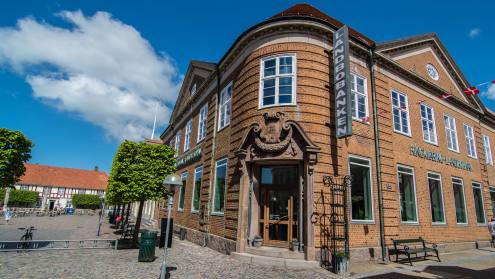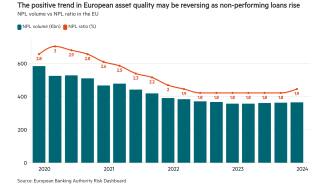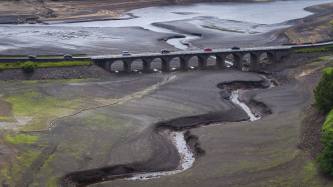While politics has dominated the headlines in Turkey in 2013, the economic outlook remains positive. Overly rapid consumer credit growth has slowed and the country's current account deficit reduced. Analysts say that this is positive for its banking sector in the medium term.
Editor's choice
Even by Turkish standards, 2013 was an eventful year. Having started the year as a model of political and economic stability, Turkey found itself being given a sharp reminder that it is still in some ways an emerging market. After 15 years of political stability, the riots which erupted across the country in June and July 2013 came as something of a wake up call.
"Investors have been reminded that political stability could be in jeopardy sometimes in Turkey," cautioned BCG partners in a written note issued shortly after the riots.
Seeking balance
The trigger to the protests may have been the decision to bulldoze a city centre park and replace it with a shopping mall. However, festering beneath this were fears that in its third term in government, prime minister Tayyip Erdogan's Justice and Development Party had lost its ability to listen to opposition concerns and was interested mainly in changing the constitution to allow Mr Erdogan to be elected as the country's executive president.
With no new constitution yet agreed it is still unclear what form the general elections and presidential elections scheduled for the next 18 months will take. What does appear clear, though, is that protests notwithstanding, Mr Erdogan does feel sufficiently confident to not see the need for a pre-election spending spree.
His government's Medium Term Programme (MTP), announced in October 2013, does project a 7% growth in investments over the next five years. However, the main beneficiaries are the agriculture and transport sectors, with projects planned including a doubling of the country's rail network, the construction of new airports and an increasing of the length of the main highways by about 50% – all measures long overdue and not regarded as evidence of 'pump priming'.
"The MTP explicitly shows [the government's] intention to have a more balanced gross domestic product [GDP] growth, rather than running after rapid GDP growth," says Nilufer Sezgin, chief economist at Erste Securities Istanbul.
That self confidence should go some way to dispelling the fears, caused both by the wave of protests and by increasing regional instability, that Turkey is becoming an increasingly risky place to do business. For the banking sector, those fears were encapsulated by the government's unusual rhetoric, targeting a body dubbed "the interest rate lobby", which it held responsible for the July riots, and rounding on the banking sector both for the rapid growth in credit card usage and the charges and fees levied on the cards themselves.
Curbing credit growth
While some of the rhetoric employed was clearly done so for political reasons, there were however good economic reasons for trying to reduce the explosive growth in credit. Loan growth hit 30.9% in early November, a slight drop on the 31% recorded at the same point in 2012 but still a long way from the stated target of 15% by the middle of 2014. Meanwhile, domestic savings remain stuck at 12%, and to date have shown no signs of rising towards the 16% target stated in the MTP.
Equally worryingly, it had become apparent that growing appetite of Turkish consumers for unrestricted cheap credit was beginning to become unsustainable. The average ratio of non-performing loans across the full range of loan products offered by the Turkish banking sector may be a comparatively healthy 2.8% but it rises to 3.5% for general purpose consumer loans and as high as 5% for credit cards, against only 1% for corporate loans.
At the same time disquiet was rising among consumers at the fees they were being charged for products which were already costing them money in the form of interest payments, with consumer groups offering advice on how to negotiate fee reductions or waivers.
Consumer law
It was against the background of rising consumer debt default and disquiet that November saw the passing of a new consumer protection law. The new law tasks Turkey’s banking regulator, BDDK, with setting the fees banks can charge for their various products, obliging banks to offer at least one 'fee free' credit card in their portfolios, and ending the charging of commissions on some credit transactions and the banning of 'early payment' fines.
At the same time the regulator has introduced new restrictions on consumer credit reducing the duration of credit card instalment payments and increasing deposit requirements for vehicle loans.
Viewed as a package, the new measures give a clear indication of the thrust of government policy. "It is trying to increase the cost of credit for banks and is also trying to curb demand," says Ms Sezgin, who adds that curbing loan growth will be an important area in 2014 and that further measures can be expected.
"It is important that the regulator and the government are taking the responsibility for lowering credit growth," she says, explaining that this allows the central bank to focus on inflation and be more orthodox in its policies.
Long-term gain
But while analysts concur that the restrictions will affect the banks' bottom lines in the short term, they also agree that they are ultimately for the good of the sector. With most credit denominated in Turkish lira, there is little risk from currency mismatches and so the main risk factor is from extending too much credit.
"The new regulations are very supportive of asset quality, so in the medium to long term we expect a much healthier sector," says Recep Demir, banking analyst at Istanbul's Garanti Securities, who adds that the volume of loans will still continue to grow, but more sustainably. However, he also cautions that he expects earnings growth for the sector in 2014 to be as low as 2%.
The broader downside of the new measures are immediately apparent, with Turkey's finance minister Mehmet Simsek accepting that restricting credit will cause a drop in domestic consumption across most sectors and that Turkey should prepare itself for a period of more modest GDP growth, albeit with the probable result that what growth does ensue will be more sustainable
Curbing credit growth may also bring an added benefit by increasing the level of savings, which has traditionally been very low in Turkey and now stands at about 12% – although the current MTP projects that this will rise to 16% over the next five years.
"Containing loan growth would help improve the savings rate, but for a permanent solution we need to produce more value-added products and to improve our productivity as well as reducing our dependency on imported energy," says Ms Sezgin.
The observation that Turkey needs to 'trade up' its high-turnover, low-grossing manufacturing sector for one that produces higher value products is not new, nor is the problem of dependency on imported energy which, thanks to high crude prices, remains a major cause of Turkey's problematic current account deficit.
Due to the continuing problems in Turkey's main European markets, exports have only just begun to recover from a slump caused by the eurozone crisis. Exports in November were reported as being just shy of $14bn, a healthy 8.8% up on the same month in 2012 but at a similar level to the preceding two months. However, imports for the same period were reported to be running between $19.3bn to $20bn, again little changed but with a consistent deficit.
Current accounting
Having navigated the global economic crisis and the eurozone crisis with comparative ease with a quick return to growth, the main domestic problem facing the Turkish economy over the past few years has been the long standing issue of the current account deficit.
Equally long-standing attempts adhere to fiscal probity succeeded in reducing the deficit from a recent peak of about 10% of GDP in 2011 to a creditable low of about 6% by mid-2012
However, subsequent events have conspired to make further reductions towards the stated 4% to 5% target impossible and have seen the deficit rise again. The nine months to September 2013 saw the current account deficit rise to $49bn, up 28% on the same period in 2012, while the corresponding 12 month figure saw the current account deficit standing at $59.1bn, or 7.2% of GDP.
External problems
The causes have been several and in most cases beyond the ability of Turkey's leaders to influence. The US-imposed sanctions on Iran from 2011 helped force up global oil prices, hitting Turkey with a double whammy. A $10 per barrel increase in crude prices is reckoned to add as much as $4bn to Turkey's annual current account deficit, given the country's dependence on imports for 90% of its oil, and on imported gas – the price of which is pegged to crude – for 50% of its power generation.
Long-term efforts to reduce Turkey's dependence on energy imports are not expected to have much effect until 2020 at the earliest. However, some relief may now be at hand with Iran's acceptance to wind down its nuclear programme, freeing the country's oil exports and helping to continue the slide in crude prices.
At the same time, the government appears to have succeeded in brokering an agreement between Iraq and its semi-autonomous Kurdistan region that will allow the free exports of the latter's oil and gas reserves through Turkey. Again, the effects of this will be slow to register, but more crude entering global markets should help push prices down, helping Turkey's deficit, while in the longer term Turkey stands to benefit from an expected discount on Kurdish gas.
More immediately though, with only about 16% of the current account deficit underwritten by foreign direct investment and with little progress in developing domestic capital markets, Turkey remains heavily dependent on foreign capital inflows.
And the US Federal Reserve's announcement in May that it plans to begin tapering will have an impact on Turkey. "Dependence on net capital inflows is one of the key risks of the Turkish economy," says a Fitch Ratings report. With the expected tapering and the need to attract capital inflows there could well be a change in interest rate policy.
A move to orthodoxy
The famed 'unorthodox measures' employed by Turkey's central bank to control flows of hot money – more accurately, a reluctance to raise headline rates – proved very effective when the central bank was trying to restrict inflows of 'hot money'.
However, since the Fed announcement, the central bank has had to battle successive runs on the Turkish lira that have seen it drop 13% to a low of about TL2.07 to the US dollar, and suffer several subsequent waves before settling at TL2.02 in late November. That stability appears to have resulted largely from an apparent shift in policy which in November saw the central bank shift away from its unorthodox policies towards a more orthodox approach.
"The central bank is focusing on the interbank overnight rate, which simplifies things for investors," says Ms Sezgin, adding that the unorthodox flexible rate corridor had been hard for many investors to understand.
Looking forward, Ms Sezgin suggests that there are signs that the central bank may terminate one-week repo funding, which she suggests will convince the markets that it is indeed taking more orthodox steps to protect the lira. "We are quite optimistic that the lira is going to be on a strengthening path next year," she says.
Supporting GDP growth
Ms Sezgin is equally optimistic that Turkey's GDP growth for 2014 can match the current government estimate of 4.2%, up from an expected 3.6% in 2013. "There is very good news such as the ongoing increase in the Purchasing Managers' Index," she says.
However, others are more cautious, with Garanti's Mr Demir suggesting that growth may be as low as 2.5%, citing in part credit restrictions. "We expect a lower contribution from the external side and a decline in domestic demand," he says.
He does point to one aspect of the changes in credit regulations that may help GDP growth, namely the reduction of the general provisioning requirement on small and medium-sized enterprise (SME) loans from 1% to 0.5%, aimed at encouraging loans to the SMEs that account for as much as 70% of the Turkish economy.
According to Mr Demir, following the restrictions on credit cards, many Turkish banks are turning to SME lending but that too presents new challenges. "It's a risky area. You need to calculate prices very well or you will meet some asset quality problems," he cautions.












